#nathaniel dance-holland
Text

1762 Sir Nathaniel Dance-Holland - Portrait of Olive Craster
(Minneapolis Institute of Art)
601 notes
·
View notes
Text

Queen Charlotte | c. 1768
Nathaniel Dance-Holland
#queen charlotte#portrait#royal portrait#baroque#1760s#18th century art#nathaniel dance-holland#classical painting#art#painting#oil on canvas#bridgerton characters#curators on tumblr
10 notes
·
View notes
Text

Love these guys by Nathaniel Dance-Holland. Wig.
4 notes
·
View notes
Text

Sir Nathaniel Dance-Holland, 1st Baronet RA (English, 1735-1811)
The Pybus family, ca.1769
#Nathaniel Dance Holland#English art#English#England#The Pybus family#1769#1700s#art#fine art#european art#classical art#europe#european#fine arts#oil painting#europa#western civilization#european history#real people#regency
21 notes
·
View notes
Note
for the colour prompt: lady stowe in dance macabre or null moon?

As beautiful as the first frost — and as cold.
#em draws stuff#the flight of the heron#the gleam in the north#lady stowe#these were both excellent palettes for her but I had to go with dance macabre because of the red and how well it worked for her Parrot#I am So afraid of her parrot by the way. wracks me with distress for reasons mysterious.#and I did not have a reference picture to work off for That otherwise it would be Scarier-Looking#the rest of it is based on nathaniel dance-holland's 1762 portrait of olive craster#which I like for its Squirrel and its Wild amounts of delicately rendered lace#which I was going to add but I found I did not actually like the look of it in my own iteration#Anyway. She :]
27 notes
·
View notes
Text
OFMD Stede Bonnet as a Macaroni: Wealth, Gender and Sexuality in the 18th Century Fashion World
Historical Inaccuracy in Our Flag Means Death? Never!
Historical inaccuracy! I hear you cry. A Macaroni in 1717!?! It is true macaroni fashion was really a late-18th century fashion trend, seemingly reaching its peak in the 1770s. However Our Flag Means Death is nothing if not historically inaccurate. Stede’s costumes seem to take inspiration from across the 18th century rather than worrying about what would have actually been worn in 1717.
Early 18th century suits tended to have round necklines, loose-fitting sleeves with wide cuffs, long waistcoats that stoped just above the knee, and coats with full skirts just a little longer that the waistcoat.

[Left: Matthew Prior, oil on canvas, c. 1713-1714, by Alexis-Simon Belle, photo credit: St John's College, University of Cambridge, via Art UK.
Middle: Matthew Hutton of Newnham, Hertfordshire, oil on canvas, c. 1715, by Johannes Verelst, photo credit: National Trust Images, via Art UK.
Right: William Leathes, Ambassador Brussels, oil on canvas, c. 1710-1711, by Herman van der Myn, photo credit: Colchester and Ipswich Museums Service: Ipswich Borough Council Collection, via Art UK.]
As the century continued we get standing collars and turned down collars but round necklines were still around as well, sleeves got tighter with smaller cuffs, the waistcoats got shorter and the coats lost their skirts.
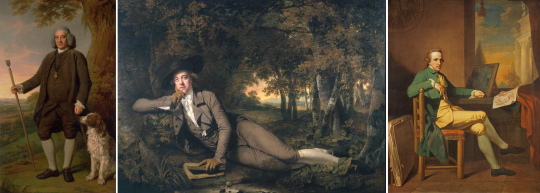
[Left: Thomas ‘Sense’ Browne, oil on canvas, c. 1775, by Nathaniel Dance-Holland, photo credit: Yale Center for British Art, via Art UK.
Middle: Sir Brooke Boothby, oil on canvas, c. 1781, by Joseph Wright of Derby, photo credit: Tate, via Art UK.
Right: David Allan, oil on canvas, c. 1770, by David Allan, photo credit: Royal Scottish Academy/National Galleries of Scotland (Antonia Reeve), via Art UK.]
Stede’s collars are inconstant some are rounded but others are turned down and Ed’s purple suit has a standing collar. Many of Stede’s coats have wide cuffs, but most have little skirt to them. His teal suit from the pilot has a bit of a skirt but its paired with a short waistcoat.

Most of Stede’s waistcoats are short with the exception of his suits from both the wedding portrait with Mary and the the family portrait. Both suits are very straight giving him a boxy appearance and are pretty different from most of the suits we see him in.

All in all I don’t think they were aiming for historically realistic clothes but with the collars, short waistcoats, and lack of skirts I get more of a late-18th century vibe.
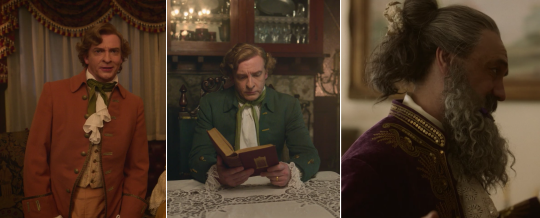
So what was a Macaroni?
A Classical Dictionary of the Vulgar Tongue (1785), defined macaroni as follows:
An Italian paste made of flour and eggs; also a fop, which name arose from a club, called the maccaroni club, instituted by some of the most; dressy travelled gentlemen about town, who led the fashions, whence a man foppishly dressed, was supposed a member of that club, and by contraction stiled a maccaroni.
The macaroni club was said to have comprised of young men who had gained a taste for French and Italian textiles on their Grand Tour (a traditional trip taken tough Europe by upper class men when they came of age). The earliest reference to the club is from a letter from Horace Walpole to Lord Hertford on the 6th Feb 1764:
at the Maccaroni Club (which is composed of all the travelled young men who wear long curls and spying-glasses),
In his book Pretty Gentleman: Macaroni Men and the Eighteenth-Century Fashion World Peter McNeil suggest the club was actually Almack’s. Almack’s was a private club at 50 Pall Mall that was attended by prominent Whigs including Sheridan, Fox and the Price of Wales. (p52) While the name may have originated from the men at Almack’s it was soon used to describe any man who followed the associated fashion trends.
So what were these trends?
Hair
“Still lower let us fall for once, and pop
Our heads into a modern Barber’s shop;
What the result? or what we behold there?
A set of Macaronies weaving hair.”
~ The Macaroni by Robert Hitchcock
Probably the most iconic aspect of macaroni fashion was the hair. “It was the macaroni attention to wigs that caused most consternation” explains Peter McNeil. The macaroni hair “matched the towering heights of the female coiffure, with a tall toupee cresting at the centre front. The wig generally had a long tail at the neck (’queue’), which when folded double was called the ‘cadogan’, all of which required regular dressing with pomade and powder, sometimes in the colours of pink, green or red.” (p45)
The height of the macaroni hair was a point of particular fascination in macaroni caricature exaggerating it beyond what the macaroni were probably actually wearing. Compare below Tom’s hair in the satirical print What is this my son Tom to the self portrait of Richard Cosway, who was satirised by Mary Darly as “The Miniature Macaroni” (a reference both to his height and his career as a miniature painter).
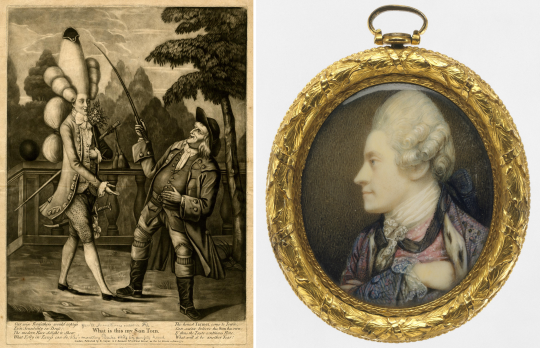
[Left: What is this my son Tom, print, c. 1774, published by Sayer & Bennett, via The British Museum.
Right: Self-Portrait, Ivory, c. 1770–75, by Richard Cosway, via The Met.]
The way Stede usually wears is hair is not particularly macaroni nor particularly 18th century for that matter. The exception to this is his wig from The Best Revenge Is Dressing Well though even this doesn’t have the iconic macaroni hight.

Interestingly both Stede and Ed are wearing flowers in their hair. While there are certainly depictions of women with flowers in there hair I’m not aware of this being a trend in mens fashion at all. However macaroni were known for wearing large nosegays.
While the tall hair was certainly iconic not all macaroni wore their hair tall. Joseph Banks, who was satirised as “The Fly Catching Macaroni” by Matthew Darly, is depicted in his portrait with a fairly typical 18th century hairstyle. Its not the hair alone that makes a macaroni, it was just one aspect of the fashion.
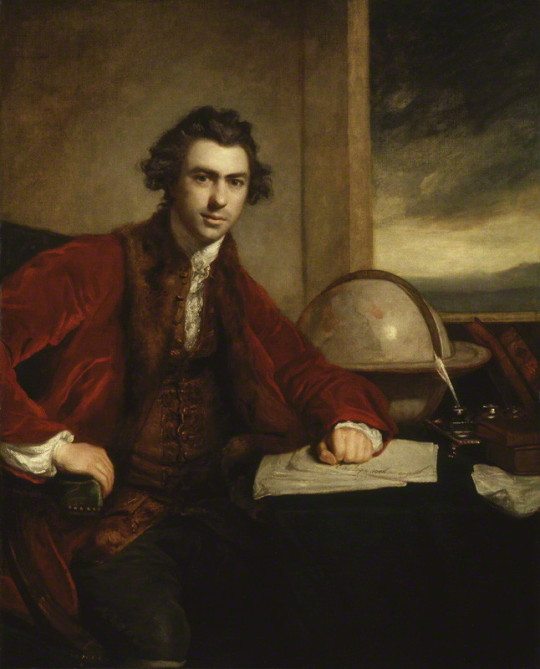
[Sir Joseph Banks, oil on canvas, c. 1771-1773, by Sir Joshua Reynolds, via Wikimedia.]
Suit
“If I went to Almack’s and decked out my wrinkles in pink and green like Lord Harrington, I might still be in vogue.” ~ Horace Walpole to Lord Hertford, 25 Nov 1764
Menswear of the period consisted of the same basic elements; shirt, stockings, breeches, waistcoat and coat. What differentiated the macaroni from others was the fabric, cut, colour and trimmings of the suit. “At a time when English dress generally consisted of more sober cuts and the use of monochrome broadcloth,” explains Peter McNeil “macaronism emphasised the effects associated with French, Spanish and Italian textiles and trimmings”. Popular amongst macaroni were brocaded and embroidered silks and velvets, sometimes further embellished with metallic sequins, simulated gemstones and raised metallic threads. Popular colours included pastels, pea-green, pink, red and deep orange. (McNeil, p30-32)
Far from wearing “monochrome broadcloth” Stede likes a “fine fabric” and dresses in a range of colours, we see him in teal, pink, purple, green, white, red, peach &c.
Tightly cut French style suits known as habit à la française were popular with macaroni. (McNeil, p14) Stede’s suits vary somewhat in cut but some are very French. The peach suit Stede wears in We Gull Way Back particularly has a very macaroni feel to me. Compare it to the English suit (left) and the French suit (right).

From the back you can see the English suit has more of a skirt to it.

Both Stede’s suit and the French suit are somewhat plain but have been paired with a floral embroidered waistcoat, while the English suit has a matching plain black waistcoat.
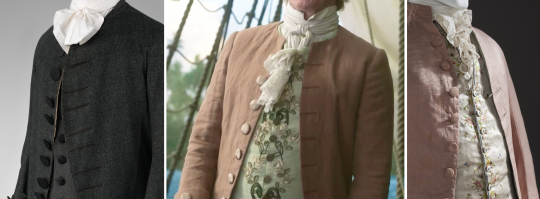
[Left: English suit, wool, silk, c. 1755–65, via The Met, number: 2009.300.916a, b.
Right: French suit, Silk plain weave (faille), c. 1785, via LACMA, number: M.2007.211.47a-b.]
Fabric covered button’s were common in the 18th century, you can see them on both the French and English coats above. In contrast Stede wears a lot of metal buttons. Steel buttons were popular amongst macaroni, a trend that was satirised in Steel Buttons/Coup de Bouton.

[Steel Buttons/Coup de Bouton, print, c. 1777, by William Humphrey, via The British Museum.]
Pumps and Parasols
“Maccaronies who trip in pumps and with Parasols over their heads” ~ Mrs Montagu
High heels had been popular amongst men during the 17th century. The Royal Collection Trust explains:
In the first half of the 17th century, high heeled shoes for men took the form of heeled riding or Cavalier boots as worn by Charles I. As the wearing of heels filtered into the lower ranks of society, the aristocracy responded by dramatically increasing the height of their shoes. High heels were impractical for undertaking manual labour or walking long distances, and therefore announced the privileged status of the wearer.
(Royal Collection Trust, High Heels Fit for a King)
In 17th century France Louis XIV popularised red-heels by turning them into a symbol of political privilege, which in turn spread the fashion to England. But with the sobering of menswear in England around the turn of the century the high heel and the red-heels went out of fashion. (see Bata Shoe Museum Toronto, Standing TALL: The Curious History of Men in Heels)
The high heel had a bit of a resurgence in the 1770s with macaroni fashion. The Natural History of a Macaroni snipes that the macaroni’s “natural hight is somewhat inferior to he ordinary size of men, through by the artificial hight of their heels, they in general reach that standard”. (Walker’s Hibernian Magazine, July 1777, p458)
Red-heels were reintroduced to England by young men returning from their Grand Tours. A young Charles James Fox (satirised by Mathew Darly as “the Original Macaroni”) wore such French style red-heeled shoes. The Monthly Magazine recalls a young Fox as a “celebrated “beau garçon” with “his chapeau bras, his red-heeled shoes, and his blue hair-powder.” (Oct 1806) and The Life of the Right Honorable, Charles James Fox recalls him in his “suit of Paris-cut velvet, most fancifully embroidered, and bedecked with a large bouquet; a head-dress cemented into every variety of shape; a little silk hat, curiously ornamented; and a pair of French shoes, with red-heels;” (p18) And in Recollections of the Life of the Late Right Honorable Charles James Fox B.C. Walpole recalls him as “one of the greatest beaus in England,” who “indulged in all the fashionable elegance of attire, and vied, in point of red heels and Paris-cut velvet with the most dashing young men of the age. Indeed there are many still living who recollect Beau Fox strutting up and down St. Jame’s-street, in a suit of French embroidery, a little silk hat, red-heeled shoes, and a bouquet nearly large enough for a may-pole.” (p24)
Compare the French style red-heeled shoes of Louis XIV to Stede’s red-heeled shoes.

[Left: detail of Louis XIV, oil on canvas, c. 1701, by Hyacinthe Rigaud, via Wikimedia.]
However most macaroni were depicted wearing the more standard late 18th century low-heeled bucked shoes. Where they distinguished themselves was the size and decoration of the buckles. “Such buckles could be set with pate (lead glass) or ‘Bristol stones’ (chips of quartz), or diamonds if you were very rich.” Explains peter McNeil, “The new macaroni fashion was for huge silver or plated Artois shoe buckles which the Mourning Post claimed weighed three to eleven ounces.” (p90)
While certainly not as iconic has his heels Stede also wears these sorts of shoes. Compare below the shoes from a macaroni caricature to Ed wearing Stede’s shoes (I couldn’t get a good shot of Stede wearing them).

[Left: detail of How d'ye like me, print, c. 1772, published by: Carington Bowles, via The British Museum.]
“A great many jewelled accessories accompanied the macaroni look”, writes Peter McNeil, “They included hanger swords, very long canes, clubs, spying glasses and snuff-boxes.” (p68) Tragically we don’t see Stede with a fashionable dress sword or a cane but we do see him with another accessory popular amongst macaroni; a parasol.
Popular in France parasols/umbrellas were adopted by the macaroni. They were popular amongst both men and woman in France but in England they had a feminine connotation. (McNeil, p129) In the 1780s as umbrellas became more popular amongst men there was a cultural pushback to the perceived gender transgression. On the 16th of August 1780 the Morning Post complains of of the “canopy of umbrellas” bemoaning that “the effeminacy of the men, inclines them to adopt this necessary appendage of female convenience”. On the the 4th Oct, 1784, the Morning Chronicle published a letter complaining of “that vile foppish practice of sheltering under a umbrella”. The author of this tirade writes that while “the ladies should be allowed to secure their beauty and persons from the heat of the sun, or the inclemency of the weather,” because “it is natural, and has a striking effect”, that “to see a great lubberly cit, bounce from his shop, with a coat, hat, and wig that are not together worth one groat,” sheltering “from the influence of the solar beam” was “intolerable.” However:
The macaroni being of the doubtful gender, may in part claim a feminine right; his dress is too delicate to bear an heavy shower, perhaps his person is so too; but a coach, if a clean one is to be found would serve his purpose much better, as there would be less likelihood of his being washed away into the kennel, which he deserves to be kicked into for his d-----d affectation.

Wealth
Born from rich young men returning from their tours with a taste for French and Italian textiles macaroni fashion was expensive. Certainly a working class man would not be able to afford Stede’s wardrobe. Both the sheer amount of clothes he has as well has the fabrics those clothes are made of are indications of wealth. However to say that Stede’s wardrobe is only an indication of wealth would be missing part of picture.
Most rich upper class English men (including colonial) wore plain monochrome suits. Even amongst the gentry macaroni fashion was not the norm. Compare bellow George Washington (left) who was a wealthy planation owner, but notably not a macaroni, to Richard Cosway (right) who was a famous macaroni.

[Left: George Washington, oil on canvas, c. 1796, by Gilbert Stuart, via Pennsylvania Academy of the Fine Arts.
Right: Detail of The Academicians of the Royal Academy, oil on canvas, c. 1771-72, by Johan Zoffany, via The Royal Collection Trust.]
In spite of the expense macaroni fashion was not exclusive to the upper classes. “Macaroni dress was not restricted to members of the aristocracy and gentry,” writes McNeil, “but included men of the artisan, artist, and upper servant classes, who wore versions of this visually lavish clothing with a distinctive cut and shorter jackets. Wealthier shopkeepers and entrepreneurs also sometimes wore such lavish clothing, particularly those associated with the luxury trades, such as mercers and upholsterers -” (p14)
It was possible to copy certain aspects of macaroni fashion on a cheeper budget. The hairstyle in particular was achievable without braking the bank. And there were ways to replicate the effects of certain expensive fashion trends for cheeper prices. For example patterns could be printed rather than embroidered.

[Left: printed waistcoat, cotton, c. 1770–90, via The Met, number: 35.142.
Right: embroidered waistcoat, silk, c. 1780–89, via The Met, number: 2009.300.2908.]
The Town and Country Magazine complains “we now have Macaronies of every denomination, from the colonel of the Train’s-Bands down to the errand-boy.” (McNeil, p169) The Morining Post mocks macaronies that couldn't financially keep up with the trends:
The macaronies of a certain class are under peculiar circumstances of distress, occasioned by the fashion, now so prevalent, of wearing enormous shoe-buckles; and we are well assured that the manufactory of plated ware was never known to be in so flourishing a situation.
(14 Jan, 1777)
In 18th century England, class was about more than just how much money you had. It was about pedigree. “English society was particularly alert to those whom it felt were using clothes to achieve a social status they did not merit” explains McNeil. Richard Cosway was a famous macaroni from modest background. Born to a Devonshire headmaster he was sent to London to study painting at 12. He became a very successful miniature painter and grew rich from the patronage of the Prince of Wales (later George IV) and Whig circles. In Nollekens and his Times J.T. Smith writes of Cosway:
He rose from one of the dirtiest boys, to one of the smartest of men. Indeed so ridiculously foppish did he become that Mat Darly, the famous caricature print-seller, introduced an etching of him in his window in the Strand, as ‘The Macaroni Miniature Painter’
(McNeil, p105-14)
But it was not only the Darlys that satirised Cosway Hannah Humphrey mocks Cosway as a social climber in A Smuggling Machine or a Convenient Cos(au)way for a Man in Miniature which depicts him standing under the petticoats of his much taller wife Maria. In the background there is a picture of Cosway climbing a ladder that rests upon a woman (she is believed to either be Angelica Kauffman or the Duchess of Devonshire). Below this reads:
Lowliness is Young Ambitions Ladder,
Whereto the climber upward turns his Face
But when he once attains the upmost round
He then unto the Ladder turns his back,
Looks unto the clouds - scornin [sic] the base degrees
By which he did assend.
Shak. Jul. Caesar.

[A Smuggling Machine or a Convenient Cos(au)way for a Man in Miniature, print, c. 1782, by Hannah Humphrey, via The British Museum.]
Another famous macaroni not born into the aristocracy was Julius Soubise. Brought to England from the West Indies as a slave he was taken in by Catherine Hyde, the Duchess of Queensbury. She gave him a leisured childhood, in which he was taught to play and compose for the violin, was taught to fence by Domenico Angelo, and learned oration from David Garrick. “Macaroni caricatures of Soubise parodied a foppish upstart whose outfits and entertainments, financed by the Duchess, affronted both racial and social expectations of an African male.” Writes Petter McNeil, Soubise was satirised as “a Mungo Macaroni” an “offensive term meaning a rude or forward black man.” (p118)
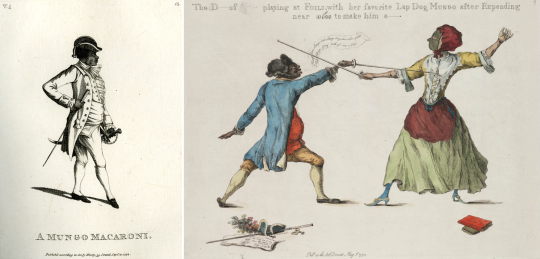
[Left: A Mungo Macaroni, print, c. 1772, by Matthew Darly, via The British Museum.
Right: The D------ of [...]-- playing at foils with her favorite lap dog Mungo after expending near £10000 to make him a----------*, print, c. 1773, by William Austin, via Yale Center for British Art.]
The expense of Stede’s wardrobe is a key part of the narrative. Stede has nice fancy luxurious things. Ed wants nice fancy luxurious things. Ed was born a poor brown boy and while he may be rich now he can never truly change his class. He could be as rich as Richard Cosway or Julius Soubise but to the gentry he will always be that poor brown boy.

Gender
As we have already seen in the tirade against men using umbrellas the macaroni was perceived as being of “the doubtful gender”. (The Morning Chronicle, 4 Oct, 1784)
The Natural History of a Macaroni writes that there “has within these few years past arrived from France and Italy a very strange animal, of the doubtful gender, in shape somewhat between a man and monkey,” that dresses “neither in the habit of a man or woman, but peculiar to itself”. The author states that “they are in no respect useful in this country”:
that the minister of the war department would give orders to have them enlisted for the service of America: we do not mean to put them on actual duty there. Alas! they are as harmless in the field, as they are in the chamber, but they may stand as faggots to cover the loss of real men.
(Walker’s Hibernian Magazine, July 1777, p458-9)
A “faggot” being “A man who is temporarily hired as a dummy soldier to make up the required number at a muster of troops, or on the roll of a company or regiment.” (see OED)

[The Masculine Gender & The Feminine Gender, etching with touches of watercolour, c. 1787, Attributed to Henry Kingsbury, via The Met.]
The macaroni wasn’t just considered effeminate because of the way they dressed but also because of their interests and the way walked and talked. Famous for playing fops and macaroni, the actor David Garrick did a lot to establish the character of the macaroni in the public mind. In his poem The Fribbleriad Garrick mocks the men who were offended by his performances asserting, perhaps accurately, that they were offended because it was them he mocked. He portrays a group of angry effeminate men meeting in order to seek revenge on him for his portrayal of them:
May we no more such misery know!
Since Garrick made OUR SEX a shew;
And gave us up to such rude laughter,
That few, ’twas said, could hold their water:
For He, that player, so mock’d our motions,
Our dress, amusements, fancies, notions,
So lisp’d our words, and minc’d our steps,
The macaroni had become more than simply an effeminate man, he had become a new sex. Something not quite man or woman. Something in-between. A new description of a macaroni asks the question:
Is it a man? ‘Tis hard to say - A woman then
- A moment pray -
So doubtful is the thing, that no man
Can say if ‘tis a man or woman:
Unknown as yet by sex or feature,
It moves - a mere amphibious creature.
(McNeil p169)
Sexuality
Much like today in the 18th century effeminacy was associated with homosexuality. Men who had sex with other men were known as mollies. A Classical Dictionary of the Vulgar Tongue (1785), defined a molly as “A Miss Molly; an effeminate fellow, a sodomite”. In the History of the London Clubs (1709), Ned Ward characterises mollies as follows:
There are a particular Gang of Wretches in Town, who call themselves Mollies, & are so far degenerated from all Masculine Deportment or Manly exercises that they rather fancy themselves Women, imitating all the little Vanities that Custom has reconcil’d to the Female sex, affecting to speak, walk, tattle, curtsy, cry, scold, & mimick all manner of Effeminacy.
“By the 1760′s,” explains Peter McNeil, “too much attention to fashion on the part of a man was read as evidence if a lack of interest in women”. (p152)
Macaroni were often portrayed as incapable or simply uninterested in sexual relations with women. This attitude is expressed by Mr. Bate in the following dialogue from The Vauxhall Affray; Or, the Macaronies Defeated:
Mr. Fitz-Gerall: I always though a fine woman was only made to be looked at.
Mr. Bate: Just sentiments of a macaroni. You judge of the fair sex as you do your own doubtful gender, which aims only to be looked at and admired.
Mr. Fitz-Gerall: I have as great a love for a fine woman as any man.
Mr. Bate: Psha! Lepus tute es et pulpamentum quæris?
Mr. Fitz-Gerall: What do you say, Parson?
Mr. Bate: I cry you mercy, Sir, I am talking Heathen Greek to you; in plain English I say, A macaroni you, and love a woman?
Mr. Fitz-Gerall: I love the ladies, for the ladies love me.
Mr Bate: Yes, as their panteen, their play-thing, their harmless bauble, to treat as you do them, merely to look at
While lack on interest in woman does not necessarily mean attraction to men, Matthew Darly takes the implication there in his 1771 set of macaroni caricatures which induces a print entitled Ganymede, a reference to Zeus’ male lover of the same name. Ganymede is believed to be a parody of Samuel Drybutter who had been arrested for attempted sodomy in January 1770. Darly also includes the character Ganymede in Ganymede & Jack-Catch. Jack-Catch is a reference to the infamous English executioner John Ketch. In the print Jack-Catch says, “Dammee Sammy you’r a sweat pretty creature & I long to have you at the end of my String.” Ganymede replies, “You don’t love me Jacky”. Jack-Catch is holding a noose with one hand and stroking Ganymede’s chin with the other. Jack-Catch is soberly dressed in typical 18th century menswear, while Ganymede’s dress is distinguished by his lace ruffles and styled wig. The print is not only suggesting that macaroni are sodomites but making a joke of the execution of them. The punishment for a sodomy at this time in England being death by hanging.

[Left: Ganymede, print, c. 1771, Matthew Darly, via The Met.
Right: Ganymede & Jack Catch, print, c. 1771, Matthew Darly, via The British Museum]
An anonymous letter to the Public Ledger (5 Aug, 1772) says blatantly what others had already implied. “The country is over-run with Catamites, with monsters of Captain Jones’s taste, or, to speak in a language witch all may understand, with MACCARONIES”. The writer warns macaroni who have “escaped detection” as sodomites and “therefore cannot fairly be charged” that they have not avoided suspicion:
Suspicion is got abroad-the carriage-the deportment-the dress-the effeminate squeak of the voice-the familiar loll upon each others shoulders-the gripe of the hand-the grinning in each others faces, to shew the whiteness of the teeth-in short, the manner altogether, and the figure so different from that of Manhood, these things conspire to create suspicion; Suspicion gives birth to watchful observation; and, from a strict observance of the Maccaroni Tribe, we very naturally conclude that to them we are indebted for the frequency of a crime which Modesty forbids me to name. Take warning, therefore, ye smirking group of Tiddy-dols: However secret you may be in your amours, yet in the end you cannot escape detection;
Bows on His Shoes
18th century shoes were typically buckled, laces and ribbons were simply unfashionable. As mentioned previously macaroni were distinguished by the size and decoration of the buckles. So are Stede’s bows simply ahistorical? Well there are references to 18th century men wearing laces and ribbons.
Towards the end of the 18th century laces started to come into fashion. Appeal from the Buckle Trade of London and Westminster, to the Royal Conductors of Fashion (1792) complained that despite how “tender and effeminate the appearance of Shoe Strings” the “custom of wearing them has prevailed.”
Perhaps the most intriguing reference is that of Commissioner Pierre Louis Foucault’s papers where he details the surveillance, investigation and entrapment of "pederasts” in Paris. It is important to note that the word “pederasty” was used synonymously with “sodomy” in the 18th century and did not denote age simply sex. An Universal Etymological English Dictionary (1726) defines “A pederast” as “a Buggerer” and “Pederasty” as “Buggery”.
Foucault and the men working with him identified particular clothing worn by men seeking sex with other men that he called the “pederastical uniform”. In Foucault’s papers men are described as being “attired in such a way as to be recognized by everyone as a pederast”, “clothed with all the distinctive marks of pederasty”, or simply “dressed like a pederast”. This “uniform” generally included “some combination of frock coat, large tie, round hat, small chignon, and bows on the shoes.” Jeffrey Merrick in his article on Foucault speculates that these men dressed this way to signal to each other. However when questioned by police they would understandably deny such a purpose, one man when questioned about his outfit responded that everyone “dresses as he sees fit”. (Jeffrey Merrick, Commissioner Foucault, Inspector Noël, and the “Pederasts” of Paris,1780-3)
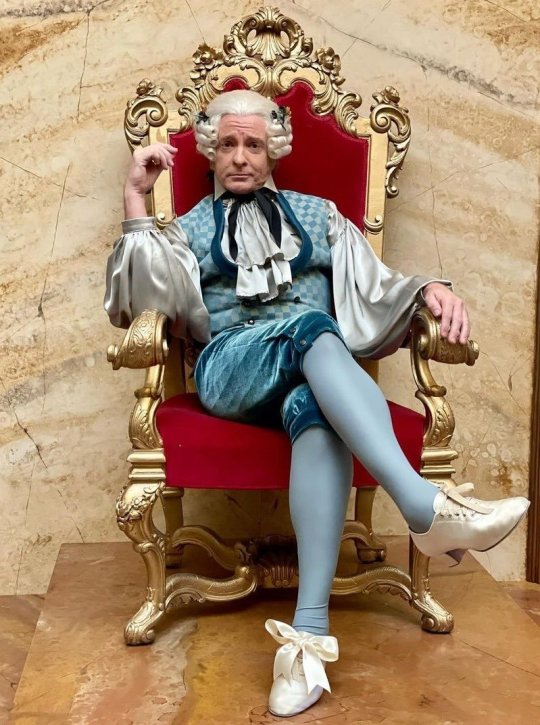
Conclusion
I’m not saying Stede is intended to be a macaroni. If that were the case they would have given him the iconic macaroni hairstyle. However the costuming team has clearly pulled from fashion trends that were associated with effeminacy and homosexuality. While OFMD is evidently wholly unconcerned with creating period accurate costumes the costumes are still clearly inspired by historical fashions. Perhaps the curtains really are just blue but maybe Stede wears bows on his shoes because he’s gay.
#I had way too much fun doing this#our flag means death#ofmd meta#stede bonnet#queer history#macaroni#historical fiction#fashion history
197 notes
·
View notes
Text
top portrayals:
LIZZY
[12] Lily James
[9] Keira Knightley, Jennifer Lawrence
[5] Imogen Poots
[4] Maisie Williams
[3] Sarah Bolger, Jenna Louise Coleman, Romola Garai, Bella Heathcote, Amber Heard, Saoirse Ronan, Emily VanCamp, Alicia Vikander
[2] Rose Byrne, Nina Dobrev, Taissa Farmiga, Sarah Gadon, Karen Gillan, Eva Green, Rosie Huntington-Whiteley, Anna Kendrick, Katie McGrath, Leighton Meester, Sophie Turner
[5] Matthew Goode, Jared Padalecki
[4] Jude Law, Aaron Paul
[3] Nathaniel Buzolic, Bradley Cooper, Hugh Dancy, John Krasinski, Landon Liborion, Miles Teller
[2] Jonas Armstrong, Justin Bartha, Douglas Booth, Thomas Brodie-Sangster, Sam Claflin, Charlie Cox, Chace Crawford, Charlie Day, Leonardo DiCaprio, Robert Downey Jr., Martin Freeman, Ryan Gosling, Tom Hardy, Tom Hiddleston, Charlie Hunnum, Jake Johnson, Harry Lloyd, James McAvoy, Mads Mikkelsen, Julian Morris, Colin Morgan, David Morrisey, Dylan O’Brien, Evan Peters, Michael Pitt, Eddie Redmayne, Andrew Scott, Bill Skarsgard, Ben Whishaw
KATE THE GREAT
[ 3 ] Astrid Berges-Frisby, Bella Heathcote
[ 2 ] Sarah Gadon, Felicity Jones
KATE AA
[ 8 ] Michael Fassbender
[ 8 ] Keira Knightley
[ 7 ] Tom Hardy
[ 6 ] Emilia Clarke, Phoebe Tonkin
[ 6 ] Jensen Ackles, Richard Armitage, Henry Cavill
[ 5 ] Emily Blunt, Nina Dobrev
[ 5 ] Nathaniel Buzolic, Sam Claflin, Luke Evans, Chris Hemsworth
[ 4 ] Jenna Louise Coleman, Michelle Dockery, Margot Robbie, Emma Watson
[ 4 ] Ben Barnes, Benedict Cumberbatch, Chris Evans, Liam Hemsworth, Jared Padalecki, Bill Skarsgard, Sebastian Stan, Toby Stevens
[ 3 ] Candace Accola, Natalie Dormer, Jessica Brown Findaly, Claire Holt, Scarlett Johanson, Freya Mavor, Katie McGrath, Natalie Portman, Charlize Theron, Emma Watson
[ 3 ] Robert Carlyle, Nikolai Coster-Waldau, Jaime Dornan, Theo James, Joseph Morgan, Julian Morris, Evan Peters, Aidan Turner
[ 2 ] Chloe Bennet, Shelley Hennig, Lena Headey, Amber Heard, Lily James, Leighton Meester, Emilie de Ravin, Krysten Ritter, Sophie Turner, Evan Rachel Wood
[ 2 ] Aneurin Barnard, Douglas Booth, Charlie Cox, Charles Dance, Hugh Dancy, Scott Eastwood, Mark Gatiss, Tom Hiddleston, Michiel Huisman, Harry Lloyd, Richard Madden, James Norton, Colin O’Donoghue, Daniel Sharman, Milo Ventimiglia
LAUREN
[ 7 ] Natalie Dormer
[ 6 ] Romola Garai
[ 5 ] Emma Stone
[ 4 ] Crystal Reed, Holland Roden
[ 3 ] Karen Gillan, Rosamund Pike, Emilie de Ravin, Eleanor Tommilson, Charity Wakefield
TINA RAE
[ 5 ] Ben Whishaw
[ 3 ] Billie Piper
[ 3 ] Dylan O’Brian, Colin O'Donoghue
[ 2 ] Alexis Bledel, Laura Carmicheal, Sarah Paulson, Lara Pulver, Taylor Swift, Anna Torv
[ 2 ] JJ Field, Freddie Highmore, Josh Hutcherson, Gabriel Mann, Dan Stevens, Max Theriot
JENN
2: Cava Delevingne, Zoey Deutch, Phoebe Tonkin, Lea Seydoux, Kristen Stewart, Suki Waterhouse, Emma Watson
3: Tom Hiddleston
2: Daane Dehann, Chris Hemsworth, Luke Mitchell
5 notes
·
View notes
Text









Pink Dresses in Oil Paintings (details)
Sir Nathaniel Dance-Holland, The Pybus family, c. 1769
John Singleton Copley, Young Lady with a Bird and a Dog, c. 1767
Edward Hughes, Juliette Gordon Low, c. 1887
Antonio Cabral Bejarano, A Bolero Dancer, c. 1842
Jean-Honoré Fragonard, Blind-Mans Buff, c. 1750/1752
Gustav Klimt, Sonja Knips, c. 1897/1898
Charles H. M. Kerr, The Rose Coloured Gown (Miss Giles), c. 1896
James Tissot, Portrait of the Marquise de Miramon, née Thérèse Feuillant, c. 1866
Frédéric Bazille, The Pink Dress, c. 1864
#oil painting#oil on canvas#details#Impressionism#pink#18th century art#19th century art#19th century fashion#18th century fashion#pink dress#fashion
3 notes
·
View notes
Text
Presenting the Royal Navy Sailor Generator + AI image generation!
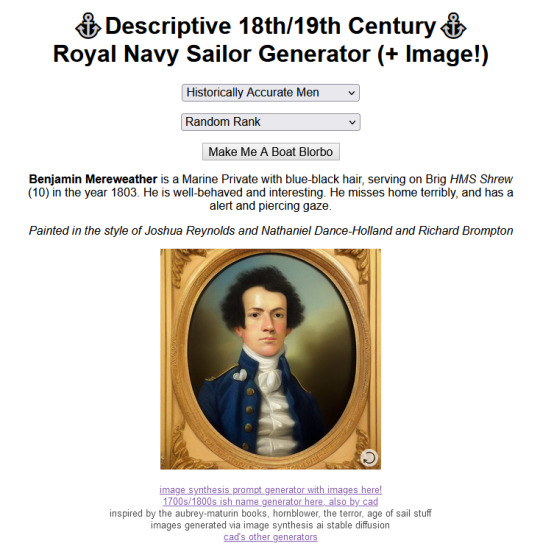
[Page may have ads, as the website owner needs to pay for the GPU hosting with ad revenue, and they're trying this out as a test to see if this is feasible so link may be temporary, more info here]
Generate your very own boat blorbo to partake in swashbuckling tales and/or descend into mutiny and cannibalism - now complete with AI image generation that may or may not picture said blorbo accurately!
Invoking the styles of the following historical portrait artists (following links to Wikipedia pages):
Joshua Reynolds, William Beechey, Thomas Gainsborough, John Singer Sargent, Benjamin West, Arthur William Devis, Gilbert Stuart, George Henry Harlow, Richard Brompton, Nathaniel Dance-Holland
As inspired by Age of Sail and Royal Navy stories such as Master and Commander/the Aubreyad, Hornblower, The Terror, Temeraire, Marryat's naval novels and more!
Non AI Image Version
Other Perchance Generators Made By Cad
#age of sail#stable diffusion#ai art#master and commander#the terror#cad commits neural network crimes#neural network art#look i got into ai art because my boyfriend said hey you can generate the images from your random sailor generations#i love procedural generation!#perchance#perchance generator
140 notes
·
View notes
Text
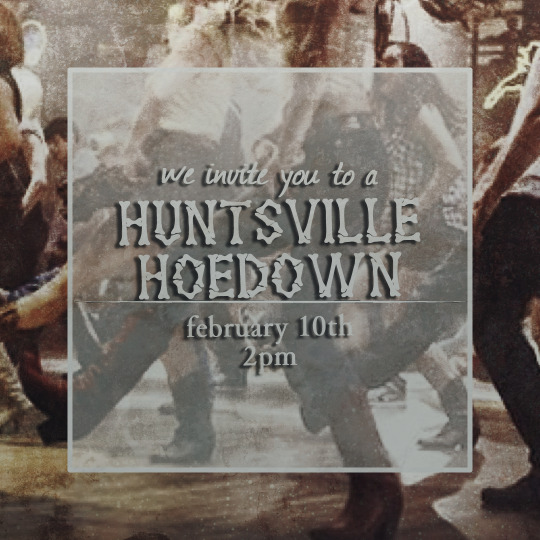
you are cordially invited to a good ol' fashioned Valentine's Day Hoedown! an event for couples and singles to get together and just have fun and perhaps forget our struggles for a little while. there will be square dancing, line dancing, and swing dancing, as well as some more modern music picks for the young ones.
food and drink will be available, as well as a cake walk, a pie eating contest and jam contest. we will have a haystack for photos, and a caricature artist.
in the spirit of the holiday, we have pre-paired individuals together for the night with matching numbered wristbands. perhaps sparks will fly?
we plan to be out of the dance hall by 5pm, plenty of time to get home before dusk.
((the event will start on feb 10th at 10am est. please tag your event starters with "huntsvilleevent01." you can post your muses' outfits starting now with the tag "huntsvilleattire." the event will last until feb 24th, with the plot drop occurring on feb 17th, giving everyone enough time to react.
you can see the paired muses below. the numbers of the list indicate what numbers are on the wristbands. you can have event threads with anyone/everyone but please have a thread with your pair. if anyone wishes to withdrawal from your pairing, please let us know before the event start so we can pair your partner with someone else.))
Tyler Rogers <-> Tristan Wilde
Silas “Cyan” Canne <-> Lincoln Abernathy
Alexandra “Xander” Thomas <-> Mallard “Duck” Romero
James “Jamie” Brennan <-> Fletcher Cole
Gianna “Gia” Rodriguez <-> Ralph Haversham
Cabell “Cab” McCay <-> Teo Ayla
Cyrus “C.B.” Vogol <-> Dakota Hart
Mateo Suarez <-> Peter “Rusty” Craven
Matthew Walker <-> Tiffany Gray
Otilie “Tilly” Notaras <-> Carter Behrens
Lachlan Ramirez <-> Christopher Winters
Bowie Bardot <-> Luciana “Lucy” Rivera
Camden Cafferty <-> Vincent Lewis
Odette Abbot <-> Reggie Alson
Nathaniel “Nate” Hoffman <-> Suneet “Sun” Dinakar
Genesis “Sissy” Boone <-> Sara Chen
Holland Bryant <-> Allison “Alice” O'Connell
Jeconiah “Jack” Abbott <-> Tari Park
Quinn Buckley <-> Emma “Em” Dunford
Olivia Hart <-> Roman Forest
Ransome “Rance” Slade <-> Cassius Romero
Wren Marsh <-> Marcel Rockfield
Freya Atkins <-> Elijah Atkins
Mason Greene <-> Josie Reigh
Conrad Greene <-> Ruben Hobbes
Katherine “Kitty” Henry <-> Monet Vogel
Catherine “Cat” Wayne <-> Jordan Kang
Hawthorne “Hawk” Romero <-> Avery Cowling
Paloma Ortiz <-> Evora Kaplan
Absinthe Capone <-> Riley Saunders
Zoë Clark <-> Luke Matthews
Axel Addams <-> Xavier Cade
Tyler Rogers <-> Tristan Wilde
Silas “Cyan” Canne <-> Lincoln Abernathy
Alexandra “Xander” Thomas <-> Mallard “Duck” Romero
James “Jamie” Brennan <-> Fletcher Cole
Gianna “Gia” Rodriguez <-> Ralph Haversham
Cabell “Cab” McCay <-> Teo Ayla
Cyrus “C.B.” Vogol <-> Dakota Hart
Mateo Suarez <-> Peter “Rusty” Craven
Matthew Walker <-> Tiffany Gray
Otilie “Tilly” Notaras <-> Carter Behrens
Lachlan Ramirez <-> Christopher Winters
Bowie Bardot <-> Luciana “Lucy” Rivera
Camden Cafferty <-> Vincent Lewis
Odette Abbot <-> Reggie Alson
Nathaniel “Nate” Hoffman <-> Suneet “Sun” Dinakar
Genesis “Sissy” Boone <-> Sara Chen
Holland Bryant <-> Allison “Alice” O'Connell
Jeconiah “Jack” Abbott <-> Tari Park
Quinn Buckley <-> Emma “Em” Dunford
Olivia Hart <-> Roman Forest
Ransome “Rance” Slade <-> Cassius Romero
Wren Marsh <-> Marcel Rockfield
Freya Atkins <-> Elijah Atkins
Mason Greene <-> Josie Reigh
Conrad Greene <-> Ruben Hobbes
Katherine “Kitty” Henry <-> Monet Vogel
Catherine “Cat” Wayne <-> Jordan Kang
Hawthorne “Hawk” Romero <-> Avery Cowling
Paloma Ortiz <-> Evora Kaplan
Absinthe Capone <-> Riley Saunders
Zoë Clark <-> Luke Matthews
Axel Addams <-> Xavier Cade
Prudence "Pru" Wheaton <-> Agna Sayer
Ivy Oberon <-> Iris Zappacosta
7 notes
·
View notes
Text
𝐎𝐰𝐞𝐧 𝐃𝐚𝐯𝐢𝐝 𝐌𝐚𝐜𝐊𝐚𝐝𝐞 | hpma minor character profile
warnings: discussions of death and cancer

✧ IDENTITY ✧
Full Name: Owen David MacKade
Nicknames: None
Name Meanings: Owen → Welsh, “young warrior ; well-born” ; David → Hebrew, “beloved” ; MacKade → Irish & Scottish, “from the wetlands.”
Date of Birth: June 3, 2003
Gender: Male ; he/him
Sexuality: Heterosexual
Blood Status: Muggleborn
Nationality: Irish

✧ APPEARANCE & VOICE ✧
Faceclaim: Noah Jupe
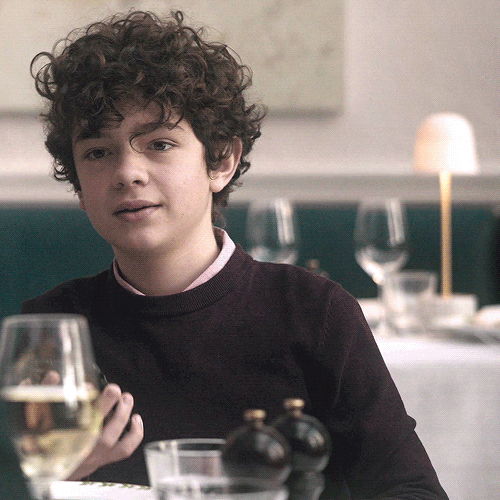
Height: 5’6”
Build: Average
Hair: Curly brown hair that’s length varies by the year
Eye Color: Brown
Defects & Modifications: He has a small scar on his left bicep.
Style: Jeans ; t-shirts ; sweatshirts ; plaid shirts ; trousers ; sweaters ; jackets ; hoodies ; sneakers
Voiceclaim: Noah Jupe
Accent: Irish
Dialect: General Irish English

✧ PERSONALITY ✧
MBTI Type: INFP — the mediator
⤷ A Mediator (INFP) is someone who possesses the Introverted, Intuitive, Feeling, and Prospecting personality traits. These rare personality types tend to be quiet, open-minded, and imaginative, and they apply a caring and creative approach to everything they do.
Positive Traits: Integrity, dedicated, intelligent, curious, supportive, athletic
Neutral Traits: Idealistic, reserved, stubborn, quiet, imaginative
Negative Traits: Sensitive, impractical, easily stressed
Interests & Hobbies: Football/soccer, hurling, cricket, reading, video games, dancing, flying, painting, writing

✧ MAGIC ✧
Wand: Owen’s wand is made of elm wood with a unicorn tail hair core and is 9 ⅘ inches long with a supple flexibility.
⤷ Elm wands preferred owners with presence, magical dexterity and a certain native dignity. Of all wand woods, elm, in Ollivander's experience, produced the fewest accidents, the least foolish errors, and the most elegant charms and spells; these were sophisticated wands, capable of highly advanced magic in the right hands (which made it highly desirable to those who espoused the pure-blood philosophy).
Patronus: Elephant
Boggart: His brother’s dead body
Riddikulus: The body pops up and does the robot dance
Amortentia: Owen smells like soap, spearmint, cinnamon, and cedarwood.

✧ HOGWARTS ✧
House: Ravenclaw
Best Subjects: Charms, herbology, history of magic, potions
Worst Subjects: Transfiguration, defense against the dark arts
Extracurriculars: Frog choir, prefect, head boy

✧ EMPLOYMENT ✧
Affiliations: Hogwarts School of Witchcraft and Wizardry
Professions:
Age 18 to 25 - Magiovet in training
Age 25 to 96 - Magiovet

✧ RELATIONSHIPS ✧
Father: David Padraig MacKade [deceased. 1965-2006]
Owen doesn’t have many clear memories of his father, as he was four when David passed away. Those memories are stronger in Owen’s mind than his memories of his mother, but not by much. He misses the man a lot and as much as Owen adores his big brothers, he wishes that he could turn to his father for things.
Mother: Clare Siobhan MacKade née O’Brien [deceased, 1967-2004]
Owen doesn’t have any memories of his mother, as he was only one when she passed away. He wishes that he could have had any memories of her and there are a lot of moments where Owen wishes that he had her to turn to. He really misses her.
Brother: Finnian Joseph “Finn” MacKade

Born on December 30, 1996, Finn is six and a half years older than Owen. They have a close relationship and Owen is probably the closest to Finn. They don’t have that many arguments because of their age gap, except when Owen feels like Finn is being too protective over him. Owen loves his big brother a lot, though.
Faceclaim: Tom Holland
Brother: Nathaniel Brian “Nate” MacKade

Born on December 30, 1996, Nate is six and a half years older than Owen. Owen probably has the most distant relationship with Nate, but they’re still fairly close. They don’t have that much in common and Owen gravitates more towards Finn anyways. However, they love each other a lot and care about one another immensely.
Faceclaim: Tom Holland
Brother: Padraig Darragh “Paddy” MacKade

Born on April 16, 2000, Paddy is three years older than Owen. They have a close relationship, partially because Finn and Nate are often together and because their age gap is smaller. They get along pretty well, although they do fight. They have a lot in common and love each other a lot.
Faceclaim: Levi Miller
Grandmother: Jean Frances MacKade née Hughes

Owen has a good relationship with his grandmother. He has always had a good relationship with her and he really looks up to. He’s not as aware of how much she does, but as an adult, he really appreciates everything that she’s done for him and his brothers.
Faceclaim: Julie Andrews
Nephews: Wyatt Hartley MacKade ; Jonah David MacKade ; Ian David MacKade
Nieces: Zoey Vanessa MacKade ; Flora Elspeth MacKade
Sisters-In-Law: Nova Luisa Hartley (@gaygryffindorgal) ; Scotty Rosier (@drinkyoursoupbitch)
Pets: A labrador retriever named Lady

✧ HISTORY & BACKGROUND ✧
Hometown: Mullingar, County Westmeath, Ireland
Pre-Hogwarts Childhood:
Born on June 3, 2003, Owen David MacKade was the fourth and youngest child pof David and Clare MacKade. He joined older brothers, Finn (6), Nate (6), and Paddy (3). Owen’s childhood was disrupted by his mother’s cancer diagnosis and her subsequent death in late 2004, when he was one. Therefore, he doesn’t have very many memories of his mother. The next disruption came when Owen was three and his father died suddenly. Thankfully, Owen’s grandmother took him and his brothers in and gave them the very best childhood that she could. The next shock, which wasn’t nearly as traumatic or difficult, was when Finn and Nate received Hogwarts letters, with Paddy receiving one a few years later. Owen was very excited when his own letter came in 2014.
Hogwarts Years:
Upon starting Hogwarts, Owen was sorted into Ravenclaw with the hat barely touching his head. He was very happy to be sorted into Ravenclaw, as he had idolized the house due to the stories that his big brother, Finn, told. He also loved being in the same house as his big brother, who helped a lot whenever Owen was feeling homesick that first year. In addition, Owen was made a prefect in his fifth year and head boy in his seventh year.
Adulthood:
After graduating from Hogwarts, Owen became a magiovet, fulfilling his fascination with magical creatures and his desire to help others. He also found himself being made the godfather of his niece, Zoey, and his niece, Flora. Like his brother Paddy, Owen took being a godfather very seriously and loved all of his various nieces and nephews.
Old Age & Death:
Owen passed away in his sleep at the age of 107.

✧ MISCELLANEOUS ✧
Trivia:
Owen’s middle name is in honor of his father.
Owen is a good listener and has a firm belief in the good of humanity, even when his beliefs aren’t always reinforced.
Owen is generally quite optimistic and is the most optimistic of the four MacKade brothers.
Owen really enjoys building with Legos, especially the more complex sets and he has a whole display of the smaller (and cheaper) architecture sets.
Owen’s great-great-great paternal grandparents were both squibs from wealthy and well-known families. They changed their surname to MacKade when they moved into the muggle world.
Important Links:
Owen’s tag [#owen mackade]
#owen mackade#hpma#magic awakened#hpma minor oc#hpma character profile#my character profile#my aesthetic#minor oc
3 notes
·
View notes
Photo

18th century Sir Nathaniel Dance-Holland - Portrait of a Young Man
(Private collection)
225 notes
·
View notes
Text
sideblog for classics and linguistics - mostly latin, some german. i ❤️ queen dido so she will appear frequently (see my pfp and header).
pfp:
Tod der Dido — Heinrich Füger

header:
The Meeting of Dido and Aeneas — Sir Nathaniel Dance-Holland

0 notes
Text
17th January
from Elegy on Captain Cook by Anna Seward
On this day in 1773, Captain James Cook, in his vessel HMS Resolution, led the first crossing of the Antarctic Circle. Cook went on to achieve several feats of exploration on behalf of the British Crown, including charting the east coast of Australia and circumnavigating New Zealand. In this elegy, for a man who would be murdered while travelling the South Seas, Seward wonders what possessed the man to take such risks.

Captain James Cook (detail) by Nathaniel Dance Holland (1775). Source: Royal Museums Greenwich website
from Elegy on Captain Cook
Say first, what Power inspir’d his dauntless breast
With scorn of danger, and inglorious rest,
To quit imperial London’s glorious domes,
Where, deck’d in thousand tints, bright Pleasure roams;
In cups of summer-ice her nectar pours,
Or twines, ‘mid wint’ry snows, her roseate bowers…
Where Beauty moves with fascinating grace,
Calls the sweet blush to wanton o’er her face,
On each fond youth her soft artillery tries,
Aims her light smile, and rolls her frolic eyes:
What Power inspir’d his dauntless breast to brave
The scorch’d Equator, and th’Antarctic wave?
For all Cook’s undoubted courage and brilliance, his death in 1779 was due to an avoidable piece of imperial arrogance. Outraged by the theft of a longboat by native Hawaiians, who had a different concept of property to that of Europeans, Cook led a party to seize the Hawaiian king and hold him hostage for the return of the boat. Cook was stabbed to death in the ensuing melee.
0 notes
Photo

Portrait of Anne, Countess of Albemarle (c.1770). Nathaniel Dance-Holland (English, 1735-1811). Oil on canvas;
In this three-quarter length portrait of Anne, Countess of Albemarle, the sitter is represented wearing a white silk dress hung with rows of pears and a blue bow at the waist, and standing by a red curtain. Influenced by the portrait style of Pompeo Batoni, Dance-Holland became a foundation member of the Royal Academy in 1768.
21 notes
·
View notes
Photo

The Misses Tracy Travell by Nathaniel Dance-Holland
32 notes
·
View notes